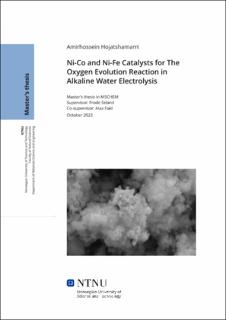| dc.description.abstract | Nickel-based catalysts were chosen for alkaline electrolysis of water due to their higher corrosion resistance and activity in alkaline environments. Alkaline membrane water electrolysis tries to combine the low cost of alkaline electrolysis with the high power and flexibility of PEM electrolyzers.
Nickel and its alloys make active, inexpensive, durable OER catalysts. Reducing an aqueous mixture of metal precursors with sodium borohydride produced NixCoy, NixFey, and Ni. To ensure reproducibility, each experiment was repeated three times.
SEM was employed in addition to EDX to investigate the surface morphology and elemental composition of the produced nickel-based catalysts. XRD was used to examine nanoparticle phase purity and crystal formation.
The XRD results agreed with the BJH and BET surface-area studies, which found a correlation between surface area and crystallite size.
Ni1Fe3 has shown a bigger surface area than Ni1Co3. The Ni1Fe3 sample's porous surface may be the reason.
According to the LSV, the most promising catalyst is the Ni1Co3 catalyst, and both Ni1Co3 and Ni1Co1 accelerate OER. Metallic Ni offers quick electron transit within the nanoparticle, which is essential for catalysis.
In this study, the ECSA and RF of these catalysts were calculated. The RF value offers insight into the topology and distribution of active sites. RF greater than 1 indicates a larger and more favorable absorption area. This research shows that all catalysts with RF values above one have favorable adsorption surface areas.
Ni1Co3 and Ni3Co1 were the best electrochemical catalysts tested. These catalysts provide a larger, more favorable adsorption area than the others evaluated.
During OER, Ni1Co3 had the highest ECSA and RF values, which means that it forms the surface that lasts the longest.
These discoveries, along with the fact that the compounds are easy to make, using abundant raw materials, and can have their catalytic efficiency fine-tuned, make them good candidates for use in energy-related applications. | |
